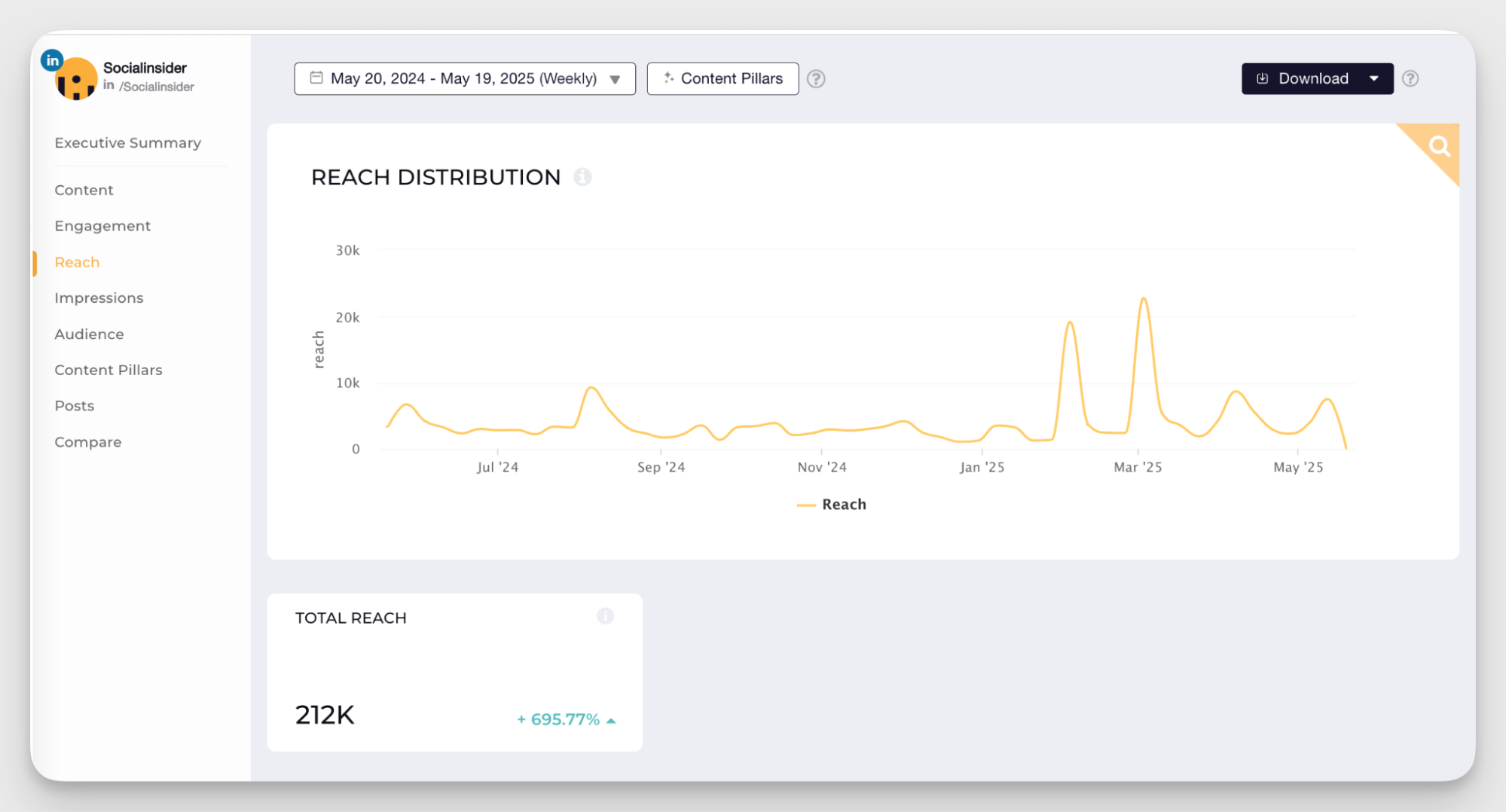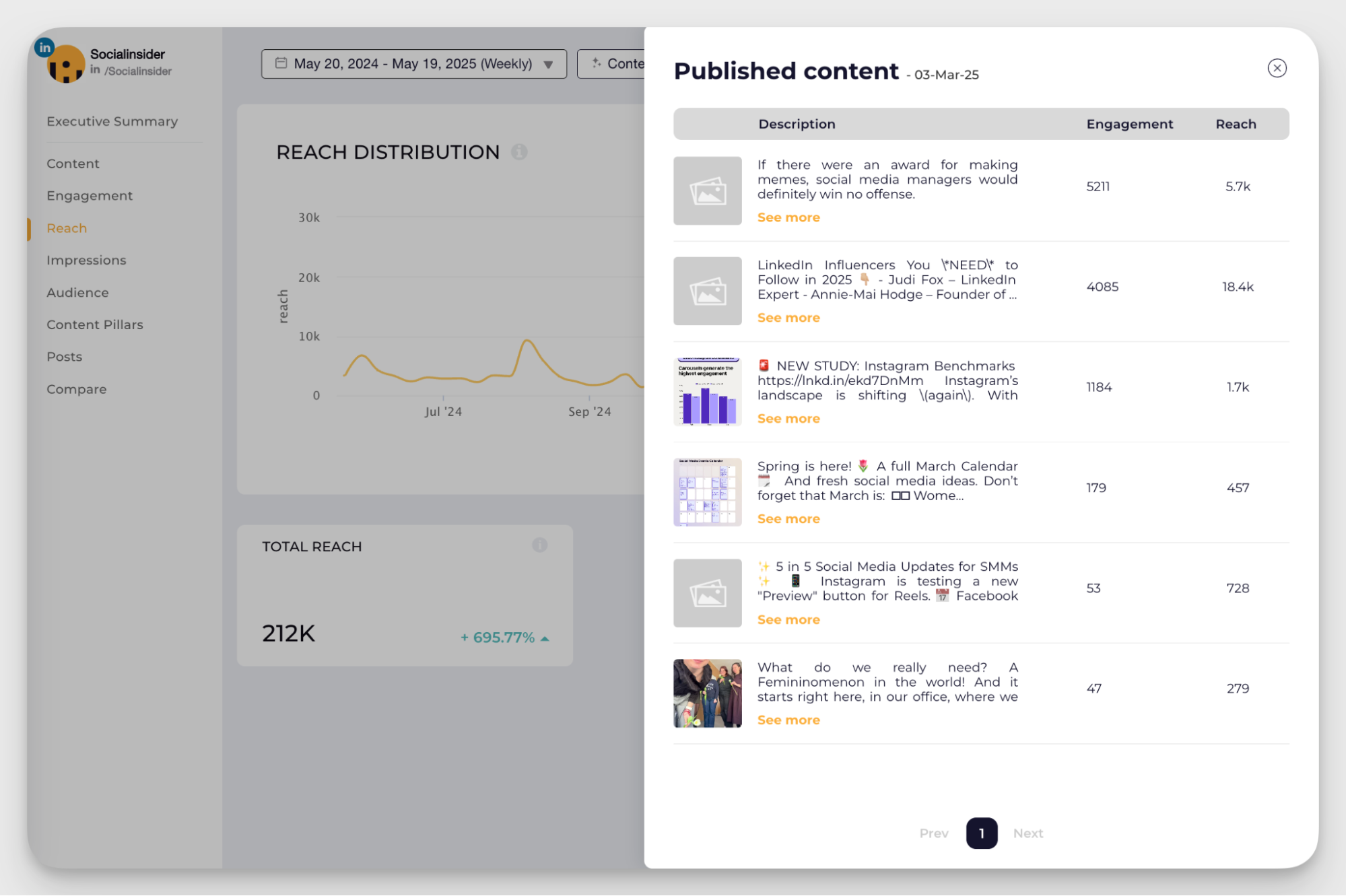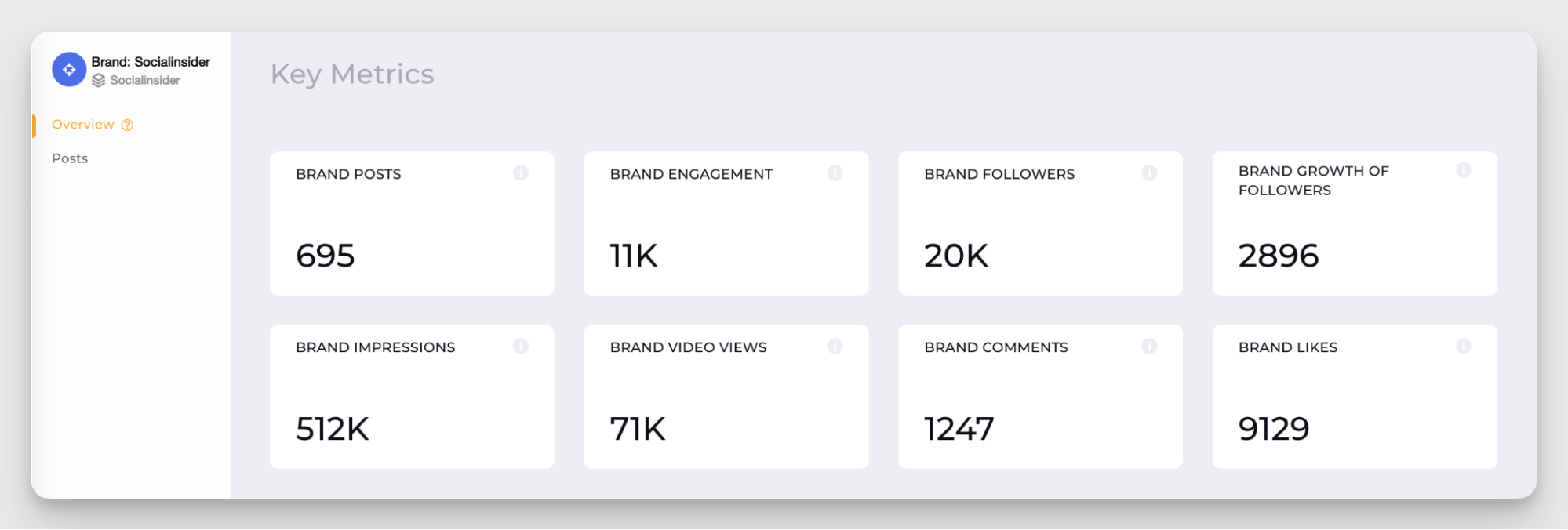Social Media Attribution Explained: How to Track ROI From Your Social Campaigns
Discover a series of social media attribution techniques that can be used to evaluate the contribution of social media to your marketing goals.


Social media drives more revenue than you realize, but you must learn how to measure it correctly. Managers who master social media attribution don't just prove ROI, they discover which content types, platforms, and social media tactics drive business growth and leverage them for building better strategies.
Below, we show you exactly how to build an attribution system that captures social media's true impact on your bottom line.
Key takeaways
-
What is social media attribution: The terms refers to the process of identifying which social media channels and touchpoints contribute to conversions or desired business outcomes.
-
Essential models:The five key attribution models are: First-touch, Last-touch, Linear, Time-decay, and U-shaped, each distributing credit differently across customer interactions.
-
How to implement it within an organization:To implement attribution, define goals, integrate analytics tools (like Google Analytics or social platforms’ native insights), and align marketing and sales data sources.
-
Impact on measuring ROI: Attribution clarifies which platforms and campaigns drive real value, enabling more accurate ROI calculations and smarter budget allocation.
What does social media attribution stand for?
Social media attribution refers to the process of identifying and assigning credit to the social media touchpoints that influence a desired action, like a website visit, form submission, or purchase.
It helps you understand how different platforms and content types influence the customer journey, so you can see what's truly driving results beyond likes or impressions.
In short, it moves you beyond surface-level social media metrics and shows how social actually supports your business goals.
Why is social media attribution important for businesses?
- It helps understand the role of social media in the customer journey: People don't usually convert after just one interaction. Attribution shows how social media fits into the broader path users take—from discovery to decision—so you can see what really moves them forward.
- It facilitates strategy optimization by identifying what platforms have a higher impact on conversions: Attribution data shows you which social platforms are bringing in high-intent traffic versus those that drive engagement but little action. This helps you allocate your time, content efforts, and budget more effectively, focusing on the channels that move the needle.
- It proves the contribution of social media in generating sales and business: At the end of the day, you want to show that social media is more than just a visibility tool — it's a revenue driver. By connecting social media efforts to tangible results like sign-ups, purchases, or leads, attribution helps demonstrate ROI and secure buy-in from stakeholders across marketing, sales, and leadership.
Five essential social media attribution models
Social media strategists trying to figure out which social media posts actually lead to sales need the right attribution model for social media marketing.
Think of these models as different lenses through which you can view your customer's journey. Each one tells a slightly different story about how your social content contributes to conversions.
#1. Linear attribution model
The linear attribution model gives equal credit to every step a customer takes before buying.
So, if someone sees your Facebook post, then your Instagram story, and finally clicks a LinkedIn ad to make a purchase, Facebook, Instagram, and LinkedIn all get an equal share of the credit for that sale.
Let's say you're running a $1,000 campaign across three social platforms, and a customer interacts with content on all three before purchasing. With linear attribution, each platform would receive 33.3% of the credit for that conversion.
When to use linear attribution:
- You want a balanced view of your entire social media marketing funnel.
- Your customers typically interact with multiple social platforms before converting.
- You're testing new platforms and want to understand their role in the journey.
Practical tips for implementation:
- Set up tracking pixels on all your social platforms to capture every interaction.
- Use UTM parameters to distinguish between different social media campaigns.
- Monitor your attribution data weekly to spot patterns in customer behavior.
#2. Time decay attribution model
The time decay model gives more credit to social media interactions that happen closer to a sale.
The idea is this: the more recent the interaction, the more important it is. So, an Instagram ad someone clicks right before buying something gets more credit than a Facebook post they liked weeks ago, though that post still gets some acknowledgment.
An example of how credit distribution works:
- Interactions within 24 hours of conversion: 40-50% credit.
- Interactions within 7 days: 20-30% credit.
- Interactions within 30 days: 10-20% credit.
- Older interactions: 5-10% credit.
Best scenarios for time decay attribution:
- You're running time-sensitive promotions or flash sales.
- Your social media conversion typically happens quickly after engagement.
- You want to identify which platforms are best at closing deals.
Practical implementation steps:
- Make sure your social media analytics platform records when people interact with your content.
- Set up reports that compare how well recent interactions perform versus older ones.
- Use this information to improve when you post and run your ads.
#3. Position-based (U-shaped) attribution model
The position-based attribution model recognizes that the first and last social media interactions are usually the most important.
For example, if someone first sees your brand on a viral TikTok, interacts with a few more posts, and then buys after clicking a Facebook ad, both that first TikTok view and the final Facebook ad get a big share of the credit.
The logic behind U-shaped attribution:
- First touchpoint: Creates brand awareness and interest (40% credit).
- Middle touchpoints: Nurture and maintain engagement (20% split).
- Last touchpoint: Triggers the actual purchase decision (40% credit).
Best use cases for position-based models:
- You want to understand both awareness-building and conversion-driving content.
- Your business has a clear consideration phase between discovery and purchase.
- You're measuring the full impact of your social media campaigns.
Implementation strategy:
- Figure out your usual customer path to see where they first find you and what makes them buy.
- Set up metrics for your awareness and conversion content.
- See which social media platforms are best at introducing your brand versus getting people to buy.
#4. Data-driven attribution models
Data-driven attribution models use machine learning to figure out what really makes your customers buy. Instead of following fixed rules, these models analyze customer journeys to see which social media interactions actually lead to sales for your audience.
This eliminates most of the guesswork because your own customer data shows you what's working. The system compares what customers who bought did versus those who didn't, highlighting the social media interactions that truly influenced a purchase.
How data-driven models work their technological magic:
- Analyze conversion paths across all your social platforms
- Compare successful vs. unsuccessful customer journeys
- Calculate each touchpoint's actual contribution to conversions
- Automatically adjust credit distribution as patterns change
When to choose data-driven attribution:
- You have substantial traffic and conversion data (for example, 12,000+ clicks and 400+ conversions per month).
- Your customer journeys are complex with multiple social touchpoints.
- You want the most accurate picture of your social media marketing performance.
Getting started with data-driven attribution:
- Collect comprehensive data across all social platforms.
- Set up Google Analytics 4 or similar advanced tracking systems.
- Allow at least 3-6 months of social media data collection before trusting the results.
#5. Cross-channel attribution models
Cross-channel attribution looks at all your marketing efforts together to show exactly how social media fits in.
You might find that social media is great for introducing your brand, while email marketing closes more sales. Or, maybe your social content is the final nudge that gets people to buy after they first found you through a search ad.
What cross-channel attribution reveals:
- How social media interacts with your other marketing channels.
- Which channel combinations produce the highest conversion rate.
- The optimal budget split across your entire marketing mix.
- Whether social media acts as an introducer, nurturer, or closer in your funnel.
Key benefits of using this attribution model for your marketing strategy:
- More accurate social media budget planning.
- Better understanding of channel synergies.
- Smarter campaign timing and coordination.
- Clearer picture of your true social media value.
Setting up cross-channel tracking:
- Implement consistent UTM tagging across all channels.
- Use a unified analytics platform that can connect data sources.
- Create customer journey maps that include all touchpoints.
- Set up regular reporting that shows channel interactions.
How to implement social media attribution within your organization?
Now that we've covered the different ways to give credit for social media efforts, let's make it work for your business. We'll walk you through how to build an effective attribution framework, including necessary tools and common mistakes.
Required tools and technologies
Getting social media attribution right requires the right tech stack. You don't need every fancy tool on the market, but you do need systems that can talk to each other and give you a complete picture of your customer journey.
Here's what we recommend for effective attribution tracking:
Google Analytics 4 (GA4)
GA4 is your central nervous system for social media attribution. It's built for cross-platform tracking and can connect the dots between your social media efforts and actual conversions.
The platform's enhanced measurement capabilities automatically track social media traffic, while its conversion modeling helps fill in gaps where traditional tracking falls short.
Set up GA4 to track:
- Social media traffic sources and referrals.
- Conversion paths that include social touchpoints.
- Custom events for social media interactions.
- Enhanced e-commerce tracking for sales attribution.
HubSpot CRM integration
Your CRM system is where attribution becomes actionable. For example, HubSpot automatically associates social media engagements with contact records, giving you a clear view of how social contributes to your sales pipeline.
Key HubSpot features for social attribution:
- Lead source attribution for social media contacts.
- Revenue reporting that includes social media touchpoints.
- Integration with social advertising platforms for complete attribution.
Surveys and direct customer feedback
Sometimes the best way to understand how social media contributes to sales is simply to ask your customers. Tools like Intercom make it easy to survey new customers about how they discovered your brand, providing valuable first-party data that complements your tracking systems.
As shown in the example below, asking "How did you hear about Socialinsider?" during onboarding gives us direct attribution data that no tracking system can dispute.

When customers report "social media" as their discovery source, you have concrete proof of social media's role in acquisition.
Practical implementation checklist:
- Connect GA4 to all your social media advertising accounts.
- Set up social media tracking for organic and paid content.
- Connect your CRM to other analytics platforms.
- Create post-purchase or onboarding surveys asking about discovery sources.
- Establish monthly reporting routines that combine all data sources.
Setting up proper tracking parameters
Attribution tracking relies entirely on good data. If your tracking isn't set up correctly, you're working without real information.
The role of UTMs, pixels, and tracking links:
UTM parameters are your main tool to avoid messy attribution data. These simple tags added to your URLs tell your analytics exactly where your website traffic comes from. However, most marketers use them wrong or inconsistently.
UTM parameter best practices for social media analysts:
- utm_source: The platform (Facebook, Instagram, LinkedIn, TikTok, etc.).
- utm_medium: The content type (social, social-paid, social-organic).
- utm_campaign: Your specific campaign name.
- utm_content: Individual post or creative identifier.
- utm_term: Audience segment or targeting details.
Social media pixel implementation:
Tracking pixels from Facebook, LinkedIn, Twitter, and other platforms are essential for linking sales back to social media. These pixels follow what users do after they leave social sites, connecting their social interactions to purchases made on your website.
Essential pixel tracking setup:
- Set up custom conversion events for key actions (purchases, sign-ups, downloads).
- Create audiences based on social media engagement for retargeting.
Advanced tracking links strategy:
Custom tracking systems capture more granular data about social media performance. Use link shorteners that preserve tracking data while providing clean, shareable URLs for social media posts.
Implementation steps:
- Create a UTM naming convention document that your entire team follows.
- Set up automated UTM generation tools to prevent human error.
- Install and test all social media pixels before launching campaigns.
- Build custom dashboards that show attribution data from all tracking sources.
Integration with other marketing channels
Social media attribution is far more useful when linked to your other marketing activities. The point isn't just to see what social media does on its own, but how it boosts all your marketing efforts.
Attribution needs your social media platforms, analytics, CRM, and other marketing tools to share data smoothly. This integration lets you see the customer's full journey, not just how each channel performs on its own.
Key integration points:
- Social media advertising platforms (natively or through analytics tools) → Google Analytics 4
- GA4 → CRM system (HubSpot, Salesforce, etc.)
- Email marketing platform → Attribution reporting
- Customer service platforms → Revenue attribution
Your integrated system should track:
- First-touch attribution (how customers discover you)
- Multi-touch attribution (all touchpoints in the journey)
- Last-touch attribution (what triggers the final conversion)
- Cross-device tracking (mobile social engagement → desktop purchase)
Practical integration steps:
- Use tools like Zapier or native integrations to connect platforms.
- Set up triggers that update attribution data in real-time.
- Create unified customer profiles that include social media engagement history.
- Build reporting dashboards that show cross-channel attribution insights.
Data collection best practices
Even small errors in data gathering can lead to big mistakes in analysis, causing you to make bad budget and strategy choices.
Essential data collection standards:
- Consistent campaign naming across all platforms.
- Standardized conversion event definitions.
- Regular data auditing to catch tracking errors.
- Backup attribution methods for critical campaigns.
Make sure to have clear rules for how you collect, store, and analyze attribution data. This means deciding how long after a social media interaction you'll count a conversion, how you'll handle duplicate data, and how long you'll keep the data.
Key data collection checkpoints:
- Weekly tracking verification across all social platforms
- Monthly attribution data audits to spot inconsistencies
- Quarterly review of attribution models and parameters
- Annual assessment of data collection tools and processes
Be aware that your attribution data collection must balance getting insights with following the law. Put systems in place to manage consent. This way, you can still get useful attribution data while respecting user privacy and local regulations like GDPR or CCPA.
Measuring ROI with social media attribution
This is where attribution moves from theory to real business impact. Once your social media attribution system tracks customer journeys, you must turn that data into clear ROI metrics. These metrics will justify your social media budget and guide your strategy.
The goal is to focus on numbers that directly link social media activity to revenue. We're talking about measuring social media's contribution in ways that truly affect your profit and impress your boss.
Key metrics to track:
- Conversion Rate by Channel: The percentage of users from each social platform who complete desired actions, helping identify which platforms drive the most valuable traffic.
- Social media leads: Prospects who've taken a qualifying action (form completion, content download) after engaging with your social content, demonstrating explicit interest beyond casual engagement.
- Social media customers: Individuals who completed a purchase with social media touchpoints in their journey, whether at awareness, consideration, or decision stages.
- CR from leads to customers from social media: The percentage of social media-generated leads who become paying customers, revealing lead quality and nurturing effectiveness across different social channels.
- Cost per Lead: The average expense to generate one qualified lead through social media, showing which platforms deliver the most cost-effective lead generation.
- Cost Per Acquisition (CPA): The total cost spent on a social channel divided by the number of conversions attributed to it, revealing which platforms provide the most cost-effective conversions.
- Return on Ad Spend (ROAS): Revenue generated per dollar spent on social media advertising, calculated by dividing attributed revenue by ad spend for each channel.
- Multi-touch Conversion Paths: The specific sequences of touchpoints that most commonly lead to conversions, revealing which combinations of channels work best together.
- Time to Conversion: The average duration between first touch and conversion for each channel, providing insight into which platforms accelerate or extend the sales cycle.
Beyond conversions: measuring brand impact
While direct sales numbers show immediate returns, they don't tell the whole story of social media's value. Brand impact metrics reveal how social media boosts all your other marketing efforts. They show how it builds awareness, creates trust, and positions your brand, all of which set the stage for sales.
Brand awareness metrics
Brand awareness metrics such as reach, impressions, and follower growth are the foundation of your social media attribution analysis. These numbers show how many people are getting to know your brand through social media, building the base of potential customers for all your future marketing.
Why reach matters for attribution: Reach shows you the unique individuals exposed to your brand through social media. Unlike impressions, which count total views, reach tells you how many distinct people are entering your attribution funnel at the awareness stage. This metric is crucial for understanding your brand's growing influence and market penetration.

As shown in SocialInsider's LinkedIn analytics example, tracking reach evolution over time reveals critical patterns for attribution analysis. There are significant reach spikes in January and March 2025, representing moments when content broke through the noise and introduced the brand to new potential customers.

In addition, Socialinsider's content analysis reveals which specific posts drive the highest reach, providing actionable insights for attribution strategy. For example, the post about "LinkedIn Influencers You NEED to Follow in 2025" was a high-performing one, giving important data about what to focus on.
Why impressions matter for attribution: While reach tells you how many people see your content, impressions reveal how often they see it.
The impressions dashboard shows how different social platforms contribute to overall brand awareness. This cross-platform view helps you understand which channels are most effective at building the brand recognition that supports attribution across your entire marketing ecosystem.

Engagement metrics
Engagement metrics offer key insights into your content's quality and how much people like your brand, which directly affects attribution results. Unlike passive awareness numbers, engagement proves active interest — the kind that leads to stronger attribution signals throughout your marketing funnel.
Why the overall engagement rate matters for attribution: Socialinsider's engagement analytics show comprehensive metrics across different calculation methods: engagement rate by followers, reach, and impressions. These varying perspectives matter because they reveal different aspects of your attribution potential.
For example, the engagement rate by followers shows how well you're activating your owned audience (highly engaged followers are more likely to convert through multiple touchpoints).

The engagement distribution chart reveals significant spikes in February and April 2025. These patterns help predict attribution performance because high-engagement periods typically correlate with increased conversion activity across other marketing channels.
Why shares matter for attribution: Shares are the most powerful form of social media engagement for attribution because people are basically recommending your brand to their friends and followers, the same as word-of-mouth marketing.
You can track specific engagement metrics like shares, both for your overall brand and for individual social media platforms.

Understanding how engagement is attributed matters for accurate performance measurement:
- Post-day attribution assigns all lifetime engagement to the original publication date, helping identify which content types drive long-term engagement that supports attribution. For example, if a post published on April 1st receives 10,000 likes over the following month, all engagement is credited to April 1st. This model helps evaluate content impact and campaign performance.
- Daily attribution credits engagement to the actual day it occurs, revealing when your audience is most active and likely to engage with attribution touchpoints. The same post's likes would be distributed across multiple days based on when users actually engaged. This approach better tracks daily activity patterns and audience behavior trends.
Practical implementation:
- Set up engagement rate tracking across all channels.
- Monitor engagement spikes and correlate them with conversion performance in other channels.
- Track share metrics separately as high-value attribution signals.
- Use both post-day and daily attribution views to optimize content timing and evaluate campaign impact.
Brand perception shifts
Engagement tells you how much interaction there is, but sentiment analysis tells you how good those interactions are.
Why sentiment matters for attribution: How people feel about your brand directly impacts their likelihood to buy. Watching changes in brand sentiment helps you predict sales performance.
Sentiment attribution tracking: Changes in brand perception impact conversions. Positive sentiment spikes often precede increases across metrics, while negative sentiment can damage attribution performance across all channels.
Practical application:
- Use social listening tools to track sentiment mentions across all platforms.
- Correlate sentiment scores with attribution performance data.
- Set up alerts for significant sentiment shifts that might impact future conversions.
- Monitor sentiment by customer segment to understand attribution impact on different audiences.
How to choose the right attribution model for your brand
Choosing the wrong attribution model is like using a screwdriver when you need a hammer. It might work, but it won't be efficient or look good. Your choice needs to match how your customers buy and what your business aims to achieve.
Mapping attribution models to marketing goals
Here are our recommendations based on experience and social media best practices:
- Brand awareness goals → Linear attribution. When building brand recognition, linear attribution gives every social media touchpoint equal credit. Perfect for new product launches or entering new markets through your social media strategy.
- Lead generation goals → Position-based attribution. For qualified lead generation, position-based attribution credits both the first touchpoint (awareness) and last touchpoint (conversion). Ideal for measuring how social media campaigns support lead generation while recognizing nurturing content.
- Sales acceleration goals → Time decay attribution. When shortening sales cycles, time decay attribution focuses on touchpoints closest to conversion. Best for limited-time promotions and optimizing immediate social media conversion rates.
- Long-term growth goals → Data-driven attribution. For complex customer journeys with substantial data, data-driven models provide the most accurate picture of social media's contribution to social media ROI.
- Multi-channel integration → Cross-channel attribution. When understanding how social media works with other marketing channels, cross-channel attribution reveals the complete customer journey and true social media value.
B2B vs. B2C considerations
The fundamental differences between B2B vs. B2C marketing require different attribution approaches.
B2B attribution requirements:
- Longer attribution windows: 90-180 days to capture extended sales cycles
- Multiple decision makers: Linear or position-based models to recognize all stakeholders
- Platform focus: LinkedIn-heavy attribution with supporting platforms
- Account-level tracking: Monitor company-wide engagement, not just individual leads
B2C attribution requirements:
- Shorter attribution windows: 7-30 days for rapid consumer decisions
- Impulse optimization: Time decay or last-click models for immediate purchases
- Platform diversity: Multi-platform attribution across Instagram, TikTok, Facebook, Pinterest, etc.
- Emotional factors: Include sentiment analysis in attribution measurement
Implementation recommendations:
- B2B: Position-based/linear models, 90-180 day windows, LinkedIn focus, account-level tracking
- B2C: Time decay/data-driven models, 7-30 day windows, multi-platform tracking, sentiment integration
Common challenges in implementing social media attribution
Challenge #1. Cross-device tracking gaps
Customers often find your brand on social media using their phones but buy on their desktop computers. Old tracking systems can't handle this, making social media look less impactful than it is.
Solution: Use Google Analytics 4's tracking and cross-device reports, along with conversion APIs from social media platforms. Connect mobile social engagement to desktop sales by using email addresses and phone numbers to link the user's activity.
Challenge #2: Attribution window confusion
Social media platforms have different default attribution windows (like 1, 7, or 28 days), which makes it hard to compare their performance accurately.
Solution: Make sure all your platforms and reports use the same attribution window. Pick a window that fits how long it usually takes for your customers to buy something — shorter for quick buys, longer for purchases that require more thought.
Challenge #3. Organic vs. paid social attribution
Many businesses struggle to tell if sales came from regular social media posts or paid ads. This leads to wrong budget decisions.
Solution: Use different UTM parameters and conversion tracking for your regular social posts and paid ads. Set up separate reports that clearly show results from organic social media versus paid social media advertising.
Challenge #4. Dark social attribution
"Dark social" refers to social sharing that happens through private channels, such as direct messages, WhatsApp, email forwards, and private group shares. This traffic appears as "direct" in your analytics, hiding significant social media attribution.
Solution: Use unique UTM parameters for all social media content to track sharing, implement link shorteners that preserve attribution data, create easily shareable content with built-in tracking parameters, and monitor direct traffic spikes that correlate with social media campaign launches.
Challenge #5. Proving social media ROI to leadership
Even with good attribution data, many businesses find it hard to explain social media's worth to executives and those who control the budget.
Solution: Create easy-to-understand reports for executives that show how social media impacts revenue, customer acquisition costs, and how much a customer is worth over time. Focus on actual business results, not just social media likes or shares.
Challenge #6. Privacy regulations
GDPR, CCPA, and other privacy regulations limit how you can collect and use customer data for attribution purposes. These regulations require explicit consent for tracking, which many users decline, creating attribution blind spots.
Solution: Get explicit consent for attribution tracking and data collection, and be clear about how attribution data is used. Also, use aggregated, anonymized data for attribution insights and build attribution models that account for missing data segments.
Final thoughts
Social media attribution doesn't need to be complicated. Pick an attribution model that fits your business goals, track consistently across all platforms, and focus on metrics that directly impact your revenue. Start simple and add complexity later. It's better to have consistent attribution that helps you make smart marketing decisions than to chase perfect attribution.
Want clear, actionable data to feel into your attribution model? Socialinsider offers complete social media analytics for all major platforms. Start your free trial today and find out which strategies actually deliver business results.
Analyze your competitors in seconds
Track & analyze your competitors and get top social media metrics and more!
You might also like
Improve your social media strategy with Socialinsider!
Use in-depth data to measure your social accounts’ performance, analyze competitors, and gain insights to improve your strategy.




